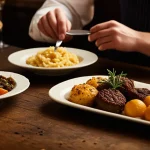Overview of Traditional UK Recipes and Their Place in Modern Cuisine
Traditional UK recipes are deeply rooted in the nation’s culinary history and continue to resonate within today’s evolving food landscape. These classic dishes, such as roast beef with Yorkshire pudding, shepherd’s pie, and fish and chips, embody the essence of British culinary traditions passed down through generations.
The lasting appeal of traditional UK recipes can be attributed to their simplicity, heartiness, and connection to regional identities. Over time, while the core essence of these dishes remains intact, many have adapted to suit contemporary palates and lifestyles. This evolution is evident in the use of fresher ingredients, innovative cooking techniques, and presentation styles that align with modern dining expectations.
Have you seen this : What Unique Flavors Define the Essence of Traditional British Cuisine?
Several factors contribute to the continued relevance of classic dishes in the UK cuisine today. These include a strong cultural attachment to heritage foods, an increasing interest in comfort foods that evoke nostalgia, and the growing appreciation for locally sourced and seasonal produce. Furthermore, traditional recipes often serve as a foundation for chefs and home cooks to experiment, blending authenticity with innovation. As a result, these classic British meals not only preserve the past but also thrive within the modern culinary scene.
Historical and Cultural Significance of Classic UK Dishes
Exploring the roots and traditions behind beloved meals
Also to read : How can you create a delicious and hearty bubble and squeak?
Traditional UK recipes are deeply intertwined with UK food history, reflecting centuries of cultural and social evolution. Many classic UK recipes, such as steak and kidney pudding and cornish pasties, originated as practical solutions to regional needs, ensuring the use of local ingredients and seasonally available produce. For instance, shepherd’s pie, with its meat and potato layers, was designed to extend modest portions into hearty meals for working families, highlighting how economy and sustenance shaped these dishes.
These recipes did more than nourish; they helped forge regional identities and customs. Each area of the UK developed its own culinary specialties, such as the Scottish haggis or Welsh rarebit, which became symbols of local pride and tradition. In rural communities, food preparation often coincided with festivals, harvests, and family gatherings, embedding classic recipes within the cultural rituals that define British society. This close relationship between food and identity underscores the cultural significance of classic UK recipes, showing how they contribute to continuity and belonging.
Moreover, traditional recipes have influenced enduring values surrounding British hospitality and social interaction. The communal sharing of meals like Sunday roasts fosters a sense of togetherness and respect for heritage. Through the lens of UK food history, it becomes clear that these dishes are more than recipes—they are vessels of meaning that connect generations, celebrate place, and maintain historical consciousness within a changing world.
Shifts in Popularity and Contemporary Adaptations
Changing tastes and lifestyles have significantly influenced the popularity of traditional UK recipes. While some classic dishes like fish and chips remain beloved staples, others have faced declining interest as people seek lighter or more diverse meals. Modern UK cooking trends reflect a shift toward healthier, more varied diets, prompting the adaptation of these traditional recipes to better suit contemporary preferences.
Chefs and home cooks have played a key role in updating traditional dishes. For example, the classic shepherd’s pie is frequently reimagined with alternative proteins or seasonal vegetables, aligning with rising vegetarian and vegan diets. Techniques such as sous-vide cooking or incorporating global spices help preserve the essence of these recipes while appealing to modern palates. This approach demonstrates how adaptation of recipes sustains their relevance without losing cultural identity.
Contemporary dietary preferences, including gluten-free and low-carb trends, also influence recipe adjustments. Ingredients are often substituted to meet these needs, ensuring classic meals remain accessible to wider audiences. At the same time, chefs emphasize fresh, locally sourced produce to enhance both flavor and nutritional value, reinforcing the connection to modern UK cooking trends. Together, these shifts illustrate a dynamic culinary landscape where tradition coexists with innovation.
Traditional Recipes Versus Contemporary Eating Trends
Traditional UK recipes continue to hold a significant place within evolving UK food trends, yet they often face competition from more modern eating habits. The contrast between traditional vs. modern cuisine in the UK primarily arises from shifts toward convenience, health consciousness, and a global palate. Unlike earlier times when meals were often homemade and centered around rich, hearty ingredients, current trends emphasize quick preparation, balanced nutrition, and diverse international flavours.
Health considerations have played a pivotal role in reshaping food choices, directly impacting the relevance of classic dishes. Many traditional meals, such as steak and kidney pudding or pie-based recipes, tend to be richer and higher in calories than modern dietary guidelines encourage. This has led to innovations that lighten classic recipes or replace heavier elements with healthier options, allowing these dishes to fit within contemporary lifestyles without losing their identity.
Globalisation has introduced a wide range of culinary influences into UK kitchens, broadening tastes beyond traditional boundaries. While this sometimes challenges the dominance of traditional UK recipes, it also invites creative reinterpretations. Fusions involving spices, cooking methods, and ingredients from other cultures demonstrate how classic British dishes can evolve to meet modern appetites while maintaining their cultural essence.
Convenience remains a defining factor in eating habits today. Ready meals, fast food, and ingredients suitable for quick cooking contrast with the preparation time traditional recipes often require. Nevertheless, many cooks and chefs balance this by offering simplified or pre-prepared versions of classic dishes, making them more accessible without sacrificing authenticity.
The prospects for the continued relevance of traditional dishes are strong as long as they adapt to reflect health, convenience, and cultural diversity. By integrating these factors, traditional UK recipes can thrive within a modern context, offering both comfort and contemporary appeal.
Perspectives From Chefs, Historians, and Locals
Insights from culinary experts on the durability or decline of classic dishes, alongside local experiences, offer a rich understanding of traditional UK recipes within a changing gastronomic landscape.
Chefs frequently emphasize the adaptability of classic British dishes as key to their endurance. Many see traditional UK recipes not as static but as flexible frameworks that invite innovation. This perspective recognizes that while some dishes face declining popularity, others gain renewed life through creative reinterpretation. For example, chefs may infuse global spices into staples like shepherd’s pie or reinvent fish and chips with healthier cooking methods. These approaches reveal that the relevance of classic dishes lies partly in their capacity to evolve without abandoning their distinctive British identity.
Food historians contribute invaluable context by tracing the origins and transformations of these recipes across centuries of UK cuisine history. Their research highlights how traditional dishes reflect social conditions, resource availability, and cultural values of different epochs. Historians often caution against viewing these foods as relics, advocating instead for appreciation of their ongoing narrative. This historical lens deepens appreciation of how classic UK recipes maintain cultural ties while accommodating new influences and tastes.
Local perspectives underscore the emotional and communal significance of traditional dishes. Many locals recall memories linked to meals like a Sunday roast or Cornish pasty, which embody family traditions and regional pride. Nostalgia plays a powerful role in sustaining these recipes, as food becomes a medium for identity and continuity. Communities often rally to preserve such dishes, whether through festivals, heritage projects, or informal sharing. This grassroots enthusiasm demonstrates that traditional UK recipes are alive not merely as culinary items but as social and cultural symbols cherished by those who hold them dear.
Together, insights from chefs, historians, and locals paint a dynamic picture of British culinary heritage. They reveal how the interplay of expertise, history, and lived experience shapes the conversation around the future of traditional UK recipes, balancing preservation with innovation for continuing relevance.




